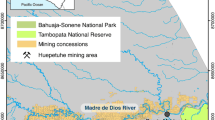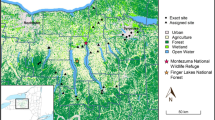Samples of bat guano, primarily from Mexican free-tailed bats (Tadarida brasiliensis), were collected at nine bat roosts in caves in northern and eastern Mexico and analysed for organochlorine residues. DDE, the most abundant residue found in each cave, was highest (0.99 p.p.m. dry weight) at Ojuela Cave, Durango. Other studies of DDE in bat guano indicate that this concentration is too low to reflect harmful concentrations in the bats themselves. The DDE at Ojuela may represent either lingering residues from use of DDT years ago in the Ojuela area of perhaps depuration loss from migrant bats with summer maternity roost(s) in a DDE-contaminated area such as Carlsbad Cavern, New Mexico. Presence of o,p′-DDT at Tio Bartolo Cave, Nuevo Leon, indicates recent use of DDT, but the concentration of this contaminant was low. Possible impacts on bat colonies of the organophosphorus and carbamate insecticides now in extensive use are unknown.
Similar content being viewed by others
References
Clark, D.R., Jr (1988) Environmental contaminants and the management of bat populations in the United States. In Szaro, R.C., Severson, K.S. and Patton, D.R., eds. Proc. Symp. Manage. Amphibs. Repts. Sm. Mamms. N. Amer., pp. 409–13, Flagstaff, Arizona. USDA Forest Service, Gen. Tech. Rep. RM-166.
Clark, D.R.Jr and Kroll, J.C. (1977) Effects of DDE on experimentally poisoned free-tailed bats (Tadarida brasiliensis): lethal brain concentrations. J. Toxicol. Environ. Health 3, 893–901.
Clark, D.R.Jr and Krynitsky, A.J. (1983) DDT: recent contamination in New Mexico and Arizona? Environment 25, 27–31.
Clark, D.R.Jr, Martin, C.O. and Swineford, D.M. (1975) Organochlorine insecticide residues in the free-tailed bat (Tadarida brasiliensis) at Bracken Cave, Texas. J. Mammal. 56, 429–43.
Clark, D.R.Jr, LaVal, R.K. and Swineford, D.M. (1978) Dieldrin-induced mortality in an endangered species, the gray bat (Myotis grisescens). Science 199, 1357–9.
Clark, D.R.Jr, LaVal, R.K. and Tuttle, M.D. (1982) Estimating pesticide burdens of bats from guano analyses. Bull. Environ. Contam. Toxicol. 29, 214–20.
Clark, D.R.Jr, Bunck, C.M., Cromartie, E. and LaVal, R.K. (1983) Year and age effects on residues of dieldrin and heptachlor in dead gray bats, Franklin County, Missouri-1976, 1977, and 1978. Environ. Toxicol. Chem. 2, 387–93.
Clark, D.R.Jr, Bagley, F.M. and Johnson, W.W. (1988) Northern Alabama colonies of the endangered grey bat Myotis grisescens: organochlorine contamination and mortality. Biol. Conserv. 43, 213–25.
Dwyer, P.D. (1966) The population pattern of Miniopterus schreibersii (Chiroptera) in northeastern New South Wales. Aust. J. Zool. 14, 1073–137.
Geluso, K.N., Altenbach, J.S. and Wilson, D.E. (1976) Bat mortality: pesticide poisoning and migratory stress. Science 194, 184–6.
Geluso, K.N., Altenbach, J.S. and Wilson, D.E. (1981) Organochlorine residues in young Mexican free-tailed bats from several roosts. Am. Midl. Nat. 105, 249–57.
Kunz, T.H. (1974) Feeding ecology of the temperate insectivorous bat Myotis velifer. Ecology 55, 693–711.
Mitchell, H.A. (1963) Respiratory physiology and anatomy in certain members of the Chiropteran family Molossidae. PhD dissertation, University of Arizona.
Moreno-Valdez, A. (1991) Mexican Cave Survey. Technical Report, Bat Conserv. Internat., Inc., Austin, TX.
Moreno-Valdez, A. (1992) Current status of Mexican free-tailed bat colonies (Tadarida brasiliensis mexicana) from Northern Mexico. Bat Res. News 33, 67 (abstract).
Thomas, D.W. and LaVal, R.K. (1988) Survey and census methods. In Kunz, T.H., ed. Ecological and behavioral methods for the study of bats, pp. 77–89. Smithsonian Institution Press, Washington, DC.
Tuttle, M.D. (1976) Population ecology of the gray bat (Myotis grisescens): philopatry, timing and patterns of movement, weight loss during migration, and seasonal adaptive strategies. Occas. Paper Mus. Nat. Hist. Univ. Kansas, 54, 1–38.
White, D.W. and Krynitsky, A.J. (1986) Wildlife in some areas of New Mexico and Texas accumulate elevated DDE residues, 1983. Arch. Environ. Contam. Toxicol. 15, 149–57.
Author information
Authors and Affiliations
Rights and permissions
About this article
Cite this article
Clark, D.R., Moreno-Valdez, A. & Mora, M.A. Organochlorine residues in bat guano from nine Mexican caves, 1991. Ecotoxicology 4, 258–265 (1995). https://doi.org/10.1007/BF00116344
Received:
Accepted:
Issue Date:
DOI: https://doi.org/10.1007/BF00116344




